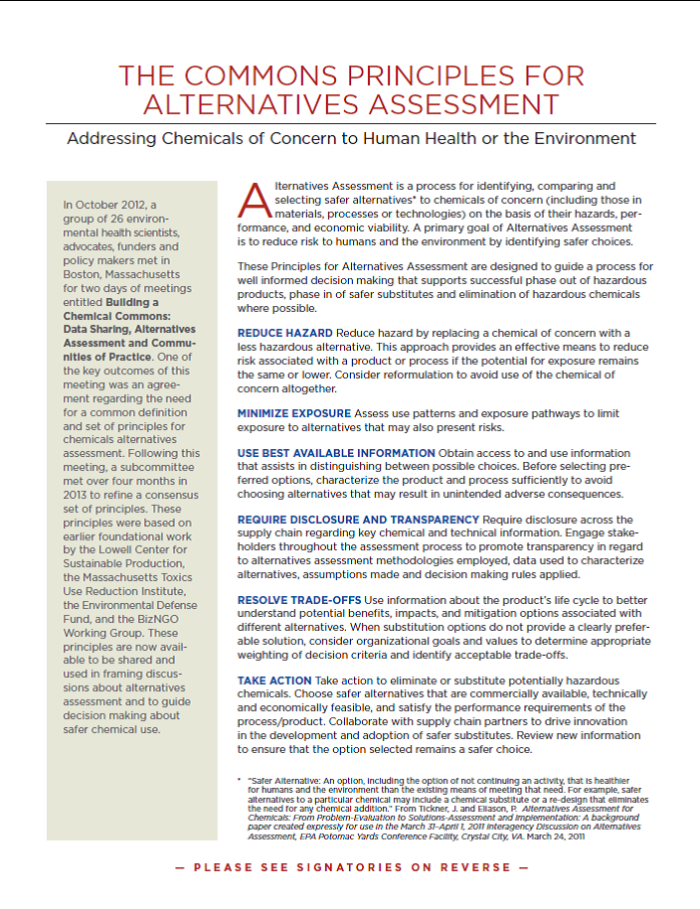
Resources
The Principles for Alternatives Assessment: Addressing Chemicals of Concern to Human Health or the Environment
In October 2012, a group of 26 environmental health scientists, advocates, funders and policy makers met in Boston, Massachusetts for two days of meetings entitled Building a Chemical Commons: Data Sharing, Alternatives Assessment and Communities of Practice. One of the key outcomes of this meeting was an agreement regarding the need for a common definition and set of principles for chemicals alternatives assessment. Following this meeting, a subcommittee met over four months in 2013 to refine a consensus set of principles. These principles were based on earlier foundational work by the Lowell Center for Sustainable Production, the Massachusetts Toxics Use Reduction Institute, the Environmental Defense Fund, and the BizNGO Working Group. These principles are now available to be shared and used in framing discussions about alternatives assessment and to guide decision making about safer chemical use.
Alternatives Assessment is a process for identifying, comparing and selecting safer alternatives* to chemicals of concern (including those in materials, processes or technologies) on the basis of their hazards, performance, and economic viability. A primary goal of Alternatives Assessment is to reduce risk to humans and the environment by identifying safer choices.
These Principles for Alternatives Assessment are designed to guide a process for well informed decision making that supports successful phase out of hazardous products, phase in of safer substitutes and elimination of hazardous chemicals where possible.
Reduce Hazard
Reduce hazard by replacing a chemical of concern with a less hazardous alternative. This approach provides an effective means to reduce risk associated with a product or process if the potential for exposure remains the same or lower. Consider reformulation to avoid use of the chemical of concern altogether.
Minimize Exposure
Assess use patterns and exposure pathways to limit exposure to alternatives that may also present risks.
Use Best Available Information
Obtain access to and use information that assists in distinguishing between possible choices. Before selecting preferred options, characterize the product and process sufficiently to avoid choosing alternatives that may result in unintended adverse consequences.
Require Disclosure and Transparency
Require disclosure across the supply chain regarding key chemical and technical information. Engage stakeholders throughout the assessment process to promote transparency in regard to alternatives assessment methodologies employed, data used to characterize alternatives, assumptions made and decision making rules applied.
Resolve Trade-offs
Use information about the product’s life cycle to better understand potential benefits, impacts, and mitigation options associated with different alternatives. When substitution options do not provide a clearly preferable solution, consider organizational goals and values to determine appropriate weighting of decision criteria and identify acceptable trade-offs.
Take Action
Take action to eliminate or substitute potentially hazardous chemicals. Choose safer alternatives that are commercially available, technically and economically feasible, and satisfy the performance requirements of the process/product. Collaborate with supply chain partners to drive innovation in the development and adoption of safer substitutes. Review new information to ensure that the option selected remains a safer choice.
* “Safer Alternative: An option, including the option of not continuing an activity, that is healthier for humans and the environment than the existing means of meeting that need. For example, safer alternatives to a particular chemical may include a chemical substitute or a re-design that eliminates the need for any chemical addition.” From Tickner, J. and Eliason, P. Alternatives Assessment for Chemicals: From Problem-Evaluation to Solutions-Assessment and Implementation: A background paper created expressly for use in the March 31–April 1, 2011 Interagency Discussion on Alternatives Assessment, EPA Potomac Yards Conference Facility, Crystal City, VA. March 24, 2011


